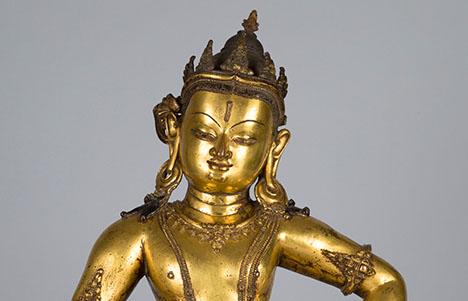
About the Meditation
Meditation session led by Sharon Salzberg
The guided meditation begins at 15:40.
For centuries Himalayan practitioners have used meditation to quiet the mind, open the heart, calm the nervous system, and increase focus. Now Western scientists, business leaders, and the secular world have embraced meditation as a vital tool for brain health.
Whether you’re a beginner, a dabbler, or a skilled meditator seeking the company of others, join expert teachers in a forty-five-minute weekly program designed to fit into your lunch break. Each session will be inspired by a different work of art from the Rubin Museum’s collection and will include an opening talk, and a twenty-minute sitting session.
This program is presented in partnership with Sharon Salzberg, the Interdependence Project and Parabola Magazine.


Related Artwork
Theme:Transforming afflictive emotions

Vajrasattva
Vajrasattva is both a highly accomplished bodhisattva and a primordial buddha who is often invoked to purify the errors made during rituals and other religious practices. His name means “vajra being,” and he is the personification of the vajra, the most important ritual implement and symbol of Esoteric Buddhism. The vajra is a symbol of power and indestructibility of the enlightened mind. This sculpture depicts the deity holding a bell at his waist, and he once held a vajra in front of his chest with his right hand.
This is an extremely elegant example of Nepalese sculpture. The figure’s well-proportioned body, with large head and strong limbs that bend as if he is dancing, perfectly combine a sense of movement and stability. The jewelry–multiple strings of pearls and narrow pointed jewel clusters around the arms and legs, which mirror the spires of the crown””further enhance the graceful appearance. The helmet-like hairstyle with the bud-shaped finial and the wide circular earrings with ornate bottom edges are characteristic of Nepalese sculpture. To create this artwork several pieces were cast separately and then welded together. The resulting joints were cleverly concealed within the figure’s ornaments, such as the armlets.
About the Speaker

Sharon Salzberg, cofounder of the Insight Meditation Society in Barre, Massachusetts, has guided meditation retreats worldwide since 1974. Sharon’s latest book is Real Love: The Art of Mindful Connection. She is a weekly columnist for On Being, a regular contributor to the Huffington Post, and the author of several other books including the New York Times bestseller Real Happiness: The Power of Meditation, Faith: Trusting Your Own Deepest Experience, and Lovingkindness: The Revolutionary Art of Happiness. Sharon has been a regular participant in many onstage conversations at the Rubin.
